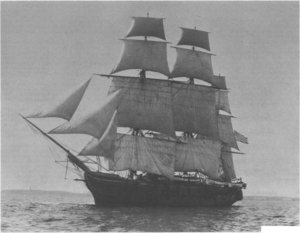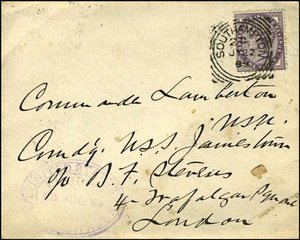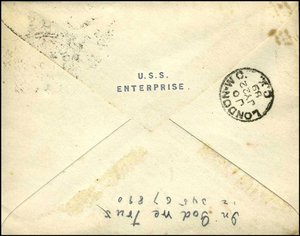JAMESTOWN
The first USS JAMESTOWN was a sloop in the United States Navy during the Mexican-American War and the American Civil War. JAMESTOWN was launched in 1844 by the Gosport Navy Yard, Virginia; and commissioned there on 12 December, with Commander Robert B. Cunningham in command.
Africa, Ireland, 1845–1850
She departed Hampton Roads on 25 June 1845 as flagship of Commodore Charles W. Skinner in command of United States naval vessels operating off the western coast of Africa to suppress the slave trade. At the end of her first deployment the sloop arrived at Boston, Massachusetts on 6 August 1846.
While she was moored at the Boston Navy Yard word reached the United States that for the second consecutive year blight had ruined the potato crop of Ireland, depriving the people of that country of their chief means of subsistence. A joint resolution of Congress approved 3 March 1847 authorized the Secretary of the Navy to place JAMESTOWN and Macedonian at the disposal of Captains Robert Bennet Forbes and George C. DeKay to carry food to the starving poor of Ireland. JAMESTOWN sailed from Boston on 28 March and arrived at Cork, Ireland on 12 April. After unloading her life-saving cargo, the sloop returned to Boston on 17 May.
As flagship of Commodore William Compton Bolton, JAMESTOWN again stood out of Boston on 22 July to operate on the west coast of Africa. A year later she was transferred to the Mediterranean Squadron to assist in protecting American citizens and interests during the epidemic of revolutions which convulsed Europe in 1848. After political conditions became more stable, JAMESTOWN returned to Norfolk, Virginia on 4 May 1850.
South America, Africa, West Indies, 1851–1860
After a year at home, she was assigned to the Brazil Squadron departing Norfolk on 1 June 1851 to begin operations off South America lasting until her return to Philadelphia Navy Yard on 2 May 1854. She decommissioned there nine days later.
Recommissioning on 22 February 1855, JAMESTOWN sailed as flagship of the African Squadron under Commodore Thomas Crabbe, departing Key West on 9 June and returning to Philadelphia on 2 June 1857 and decommissioning. She re-commissioned on 16 December and cruised the West Indies with the Home Squadron until decommissioning at Philadelphia, Pennsylvania on 14 February 1860.
Civil War, 1861–1865
After the outbreak of the Civil War, JAMESTOWN re-commissioned on 5 June 1861 and was assigned to the Atlantic Blockading Squadron, where she compiled a record of outstanding efficiency. The sloop chased the bark ALVORADO ashore off Fernandina, Florida and set her on fire on 5 August, and captured the schooner AIGBURTH off the coast of Florida on 31 August 1861. Four days later she captured, dismantled, and scuttled the schooner COLONEL LONG. Next she captured the schooner HAVELOCK on 15 December. Her final prize was the brig INTENDED, taken off Wilmington, North Carolina on 1 May 1862.
JAMESTOWN departed for the Pacific on 12 October to protect American commerce from Confederate privateers; and she remained on that duty until after the end of the war, decommissioning at Mare Island on 17 September 1865.
Pacific, 1866–1881
Having been converted to a transport and store ship, she recommissioned on 3 September 1866 to serve at Panama as a store and hospital ship. Because of fever on board, JAMESTOWN was ordered north on 2 April 1867 and was disinfected at San Francisco, California. Joining the North Pacific Squadron, she served as guard and storeship at Sitka, Alaska, from 11 September 1867 until 30 May 1868. JAMESTOWN was present at the hoisting of the U.S. Flag at Sitka on 18 October 1867 after Alaska was purchased from Russia.
JAMESTOWN arrived at Mare Island on 23 July 1868; decommissioned there on 13 August; and recommissioned on 25 January 1869, following repairs. For almost three years, JAMESTOWN cruised the Pacific on the west coasts of North and South America, and as far west as Tahiti and the Fiji and Hawaiian Islands.
Decommissioning on 7 October 1871, JAMESTOWN was placed in ordinary at Mare Island until 16 March 1876 when she recommissioned for use as a State Public Marine School. She operated at the Hawaiian Islands in this capacity until she was returned to the Navy Department and decommissioned on 3 March 1879.
She was recommissioned on 8 May and sailed for Sitka, Alaska, where she surveyed the harbor and protected American interests. In 1881, she sailed the Pacific until decommissioning at San Francisco on 21 September.
Training & Hospital Ship, 1882–1913
Having been fitted out as an apprentice training ship, JAMESTOWN recommissioned on 14 February 1882 and proceeded to the Atlantic coast via Cape Horn. In her new capacity, she sailed the Atlantic Ocean, voyaging to the West Indies, Spain, and as far north as the State of Maine. On 31 August 1888, she decommissioned at Norfolk.
Recommissioning 13 April 1889, JAMESTOWN cruised to France and to the West Indies with apprentices, and decommissioned again on 6 September 1892 at Norfolk.
On 9 September she was transferred to the Treasury Department for Marine Hospital Service for quarantine purposes in Hampton Roads. She was destroyed by fire at the Norfolk Navy Yard on 3 January 1913, after being returned to the Navy Department." {DANFS}
| Thumbnail Link To Cachet Close-Up Image | Thumbnail Link To Full Cover Front Image | Thumbnail Link To Postmark or Back Image | Primary Date Postmark Type Killer Bar Text --------- Cachet Category |
|---|
|
N/A |
 |
N/A |
N/A |
|
N/A |
USS JAMESTOWN
|
N/A |
 |
N/A |
1889-07-22 |
|
Mail from Sailor aboard USS Enterprise |
Addressed to Commander Benjamin P. Lamberton, USN
|
N/A |
 |
N/A |
1889-07-22 |
|
Mail from Sailor aboard USS Enterprise |
Addressed to Commander Benjamin P. Lamberton, USN
If you have images to add to this page, then either contact the Curator or edit this page yourself and add them. See Editing Ship Cover Pages for detailed information on editing this page.
Copyright 2024 Naval Cover Museum